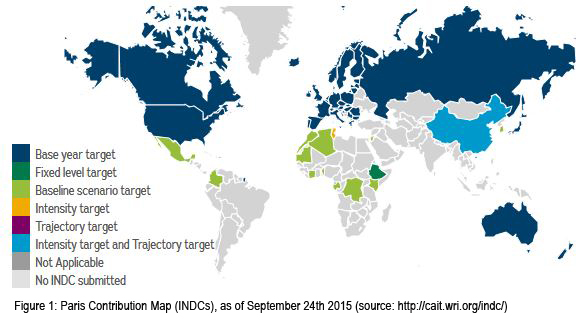Climate Policy Negotiations – Insights from Game Theory

Three main questions are at the core of the negotiations about climate change policies: What are the expected impacts from climate change due to emissions of greenhouse gases? Moreover, how much does it cost to mitigate emissions and decarbonize our energy system to prevent such impacts? Finally, even if everyone can agree on a global climate policy goal or regime, how should the costs be distributed across different countries? The latest IPCC report (IPCC 2014a) provides an in-depth assessment of expected impacts from climate change. These may be significant, and could potentially lead to catastrophic events such as the complete disintegration of the West Antarctic ice shield. Achieving a stabilization of global temperature rise between 2and 2.5 degrees centigrade above the preindustrial level is widely considered by scientists as a relatively safe global target in order to avoid much larger impacts. In the third part of the AR5 report (IPCC 2014b), the mitigation options and associated costs are discussed in details. Limiting global warming will require countries to significantly cuts their emissions of greenhouse gases, between 50-80% by 2050 with respect to today’s emissions. This implies among others a (costly) major restructuring of our fossil fuel based energy system, a reduction of deforestation, or the use of advanced technologies to reduce emissions.
The significant forecasted impacts of climate change as well as the projected costs of mitigation are - despite all scientific progresses - uncertain and very different across countries. This large heterogeneity across countries includes different income levels, exposure to extreme events or inundation e.g., for small island states, and very different abatement costs. Therefore, countries might have very different viewpoints on how a global agreement on climate change should look like and how policy costs should be shared across its signatories. Moreover, countries might decide to simply not sign at all such a proposed agreement if it is not in their own interest. These questions have been at the core of the study of game theorists, both by economists and political scientists.

Recent research has extended these results to take into account the heterogeneity between countries including using real-world data to assess which climate coalition is likely to provide a potentially stable climate agreement. For instance, Brechet et al. (2011) showed that while smaller agreements can be relatively easily achieved, compensation payments are needed if a global agreement involving a large number of emitting countries is desirable. Moreover, the results depend on what is assumed to happen in case a coalition collapses. In a recent paper, we use different numerical models of the economy and climate change to analyse the outcomes using more realistic models (Lessmann et al. 2015). Our research shows that there is a scope for a potential welfare, which can improve climate agreements, even though it might not involve all countries.
Another important aspect of negotiating a climate treaty is the significant uncertainty about costs and benefits of climate mitigation. Uncertainty can in fact make it harder to reach an agreement. Indeed, what level of mitigation should be reached as countries are not sure about the benefits to expect from such an agreement? One important source of uncertainty or risk stems from the so-called “tipping elements” in the climate system. Examples include the die-back of the Amazonian rain forest or a collapse of the thermohaline circulation in the Atlantic Ocean. If we were to know that, as scientists suggest, that at some degree of global warming, say two degrees, such a tipping point is reached, global negotiations would be very different. If everyone can agree that crossing this threshold can have such disastrous impacts, the focus of negotiations would not anymore be the level of global warming to admit, but rather how to share the burden of achieving this target. Barrett (2013) showed that the threat of such a climate catastrophe can therefore facilitate reaching a global agreement. However, given that the precise level of climate change when such event can occur is uncertain, cooperation might again collapse.
This year could prove to be crucial for achieving a global climate agreement to limit global warming to acceptable levels. However, negotiators need to take into account the strategies of all participating countries in order to design a treaty which can thereafter also be followed by all member countries. Better knowledge about the possibly high costs of climate change including possibly catastrophic events provide a better ground to base negotiations upon. Moreover, the large heterogeneity between countries needs to be taken into account when designing implementation mechanisms (such as a global permit market or a tax on greenhouse emissions including transfer mechanisms and compensation payments). Similarly, linking an agreement to other topics such as international trade regulations or other economically benefits to participating countries can help to achieve a global climate policy that can be supported by a larger number of countries. In this way, an ex-ante difficult global agreement can become feasible and possibly successful, as it has been the case for instance for the Montreal Protocol in 1987, which managed to protect effectively the ozone layer through an agreement on the phase-out of ozone depleting substances.
References:
Barrett, S., 2013. Climate treaties and approaching catastrophes. Journal of Environmental Economics and Management, 66(2), pp.235–250.
Brechet, T., Gerard, F. & Tulkens, H., 2011. Efficiency vs. Stability in Climate Coalitions: A Conceptual and Computational Appraisal. The Energy Journal, Volume 32(Number 1), pp.49–76.
Carraro, C. & Siniscalco, D., 1993. Strategies for the international protection of the environment. Journal of Public Economics, 52(3), pp.309–328.
Chander, P. and Tulkens, H., 1997. The Core of an Economy with Multilateral Environmental Externalities. International Journal of Game Theory, 26(3), pp. 379-401.
IPCC, 2014a. Climate Change 2014: Impacts, Adaptation, and Vulnerability. Part A: Global and Sectoral Aspects. Contribution of Working Group II to the Fifth Assessment Report of the Intergovernmental Panel on Climate Change [Field, C.B., V.R. Barros, D.J. Dokken, K.J. Mach, M.D. Mastrandrea, T.E. Bilir, M. Chatterjee, K.L. Ebi, Y.O. Estrada, R.C. Genova, B. Girma, E.S. Kissel, A.N. Levy, S. MacCracken, P.R. Mastrandrea, and L.L. White (eds.)], Cambridge, United Kingdom and New York, NY, USA: Cambridge University Press.
IPCC, 2014b. Climate Change 2014: Mitigation of Climate Change. Contribution of Working Group III to the Fifth Assessment Report of the Intergovernmental Panel on Climate Change [Edenhofer, O., R. Pichs-Madruga, Y. Sokona, E. Farahani, S. Kadner, K. Seyboth, A. Adler, I. Baum, S. Brunner, P. Eickemeier, B. Kriemann, J. Savolainen, S. Schlömer, C. von Stechow, T. Zwickel and J.C. Minx (eds.)], Cambridge, United Kingdom and New York, NY, USA: Cambridge University Press.
Lessmann K., Kornek U., Bosetti V., Dellink R., Emmerling J., Eyckmans J., Nagashima M., Weikard HP., & Yang Z., 2015. The stability and effectiveness of climate coalitions: a comparative analysis of multiple integrated assessment models. Environmental and Resource Economics, forthcoming.
About the Author

Johannes Emmerling is a Senior Researcher at Fondazione Eni Enrico Mattei (FEEM), in the research programme on Climate Change and Sustainable Development. FEEM is a non-profit, nonpartisan research institution devoted to the study of sustainable development and global governance established in 1989, providing timely and objective analysis on a wide range of environmental, energy and global economic issues. He holds a Ph.D. from the Toulouse School of Economics, a M.A. in Economics from the Free University Berlin and a B.Sc. in Economics from the University of Heidelberg. He is co-leading the development of the game theoretic integrated assessment model WITCH at FEEM. His main areas of research include Climate change and Energy economics, International Environmental Agreements, Risk and Uncertainty, Welfare Economics and Development.
